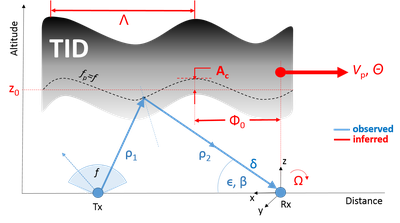TID identification with bistatic HF sounders’ operations
A new technique, based on the analysis of oblique Digisonde-to-Digisonde (D2D) “skymap” observations, is proposed by Reinisch et al. (2018) to identify in real-time Travelling Ionospheric Disturbances (TIDs) and specify the TID wave parameters based on the measurement of angle-of-arrival, Doppler frequency, and time-of-flight of ionospherically reflected high-frequency (HF) radio pulses. The technique has been implemented in the European Network of Digisondes and the results are demonstrated in the TechTIDE warning system http://tech-tide.eu/ (Belehaki et al., 2020).
 The TID model as a perfectly reflecting corrugated mirror (dashed line) moving across the area (red arrow) and causing variations of the oblique-incidence signal (blue line) characteristics {ρ(t), δ(t), ε(t), β(t)}.
The TID model as a perfectly reflecting corrugated mirror (dashed line) moving across the area (red arrow) and causing variations of the oblique-incidence signal (blue line) characteristics {ρ(t), δ(t), ε(t), β(t)}.
References:
- Belehaki, A., I. Tsagouri, D. Altadill, et al., 2020, An overview of methodologies for real-time detection, characterisation and tracking of traveling ionospheric disturbances developed in the TechTIDE project, Journal of Space Weather and Space Climate, https://doi.org/10.1051/swsc/2020043
- Reinisch B, Galkin I, Belehaki A, Paznukhov V, Huang X, et al. 2018. Pilot ionosonde network for identification of traveling ionospheric disturbances. Radio Sci 53: 365–378. https://doi.org/10.1002/2017RS006263.
